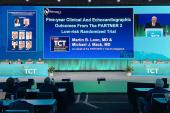Isolated vs Concomitant SAVR Offer Similar 5-Year Outcomes: PARTNER 3
The results are “very comparable” to real-world data, Vinod Thourani said at STS. Others agreed they support SAVR’s safety.

SAN ANTONIO, TX—Among patients at low risk for surgery treated with SAVR in the PARTNER 3 trial, there were no differences in the primary endpoint of all-cause mortality, stroke, and rehospitalization at 5 years between those who underwent isolated versus concomitant surgery, according to a new subanalysis.
Notably, however, the stroke rate was more than doubled with concomitant AVR, which accounted for a quarter of the procedures.
The data confirm that isolated SAVR is as safe as what was seen last year in an analysis of similar real-world patients from the Society of Thoracic Surgeons (STS) Adult Cardiac Surgery Database, said Vinod Thourani, MD (Piedmont Heart Institute, Atlanta, GA), who presented the findings as a late-breaker at the 2024 STS meeting.
“We were happy to see that,” he told TCTMD. “But we also, secondarily, saw in the PARTNER 3 study—those sites with those surgeons—[that] we actually did have great outcomes in the concomitant procedures also. So really, overall it was a confirmation of the database, but also to ourselves . . . . We need to be proud of it, because the data we’re showing is excellent.”
Though the surgeons commenting on the data during the session seemed to agree that 5-year data is too short to be truly confident—surgical valves tend to last upward of 12 to 15 years—the overall sentiment was good.
“I think we can take some comfort that there is no signal in either arm at 5 years,” said Michael Mack, MD (Baylor Scott & White Health, Plano, TX), who reviewed the main PARTNER 3 data during the session. “This is the first time that we have systematic, complete, core lab-adjudicated outcomes of surgical valves. It's never been done before.”
With other concerning data also presented at STS showing potential indication creep of TAVI into younger people where guidelines still recommend surgery, many during the session argued that the PARTNER 3 results should be presented to patients, as well as referring cardiologists, in order to reassure them of the overall safety of SAVR.
“Our community is struggling,” Thourani said. “I get 50% of my calls saying, ‘Surgery looks equivalent,’ and 50% say, ‘Surgery looks terrible or inferior.’” Part of the reason they did the analysis was to address the notion that SAVR is not as good as or no better than TAVI, he noted. “People are confused and I don’t know what to tell them necessarily. That's part of [why] we've got to figure this out as surgeons.”
SAVR has the only “class 1 indication for patients less than 65 years old,” Mack said. “Despite that, the [TAVI] age creep is occurring. It's not because our cardiology colleagues are nefarious, it's because that's what patients come in asking for.”
PARTNER 3 Data
For the subanalysis, Thourani and colleagues included low-risk patients from PARTNER 3 who either underwent isolated (n = 295) or concomitant AVR (n = 106) during the trial. In the concomitant group, CABG was the most commonly performed surgery (12.8%), followed by left atrial appendage closure (9.5%), Maze ablation (4.8%), and root enlargement (4.6%).
Baseline characteristics were similar between the cohorts—mean age 73.6 years and 71.1% male—but those receiving concomitant operations were more likely to have CAD (49.2% vs 20.4%) or atrial fibrillation (35.8% vs 12.6%; P < 0.0001 for both) as well as to require a permanent pacemaker (5.8% vs 1.8%; P = 0.048). Concomitant AVR was also associated with longer procedure and anesthesia times, and more of these patients required a full sternotomy (P < 0.001 for all).
Across the board, the most common surgical valve sizes were 23 and 25 mm, each of which were implanted in about one-third of cases. The most commonly used valve type was Perimount/Magna (73.3%; Edwards Lifesciences), but notably, 16.7% of patients received a Trifecta (Abbott) valve, which later was found to have durability issues and is no longer manufactured.
At 5 years, there were no differences between isolated and concomitant SAVR regarding the composite primary endpoint of the study (all-cause mortality, stroke, or rehospitalization) or all-cause mortality and rehospitalization as individual endpoints. Stroke, however, was more common for those undergoing concomitant procedures. There was no significant difference in the risk of death or disabling stroke.
5-Year Outcomes
|
|
Isolated SAVR |
Concomitant SAVR |
HR |
95% CI |
|
Primary Endpoint |
26.0% |
30.3% |
0.87 |
0.58-1.30 |
|
All-Cause Death |
7.8% |
9.2% |
0.84 |
0.40-1.76 |
|
Stroke |
4.8% |
11.2% |
0.44 |
0.21-0.94 |
|
Rehospitalization |
17.8% |
16.4% |
1.13 |
0.66-1.92 |
|
Death or Disabling Stroke |
9.4% |
11.0% |
0.85 |
0.43-1.66 |
When the researchers compared those who had CABG versus other procedures within the concomitant population, there were no significant differences in any of the endpoints, including stroke. However, Thourani pointed out, the stroke and rehospitalization rates were numerically higher in those undergoing non-CABG procedures in addition to SAVR, with the curves diverging around 1 year.
Among those who had root enlargement in addition to SAVR, mortality within the first 12 months was higher than among those who had CABG or other concomitant procedures, but Thourani said the risk was mostly operative and rates stabilized afterwards.
On multivariate analysis, only root enlargement trended toward being a significant risk factor for all-cause death at 5 years (HR 2.75; 95% CI 0.83-9.15).
I think we can take some comfort that there is no signal in either arm at 5 years. Michael Mack
Thourani argued that these results can be generalizable to real-world practice, noting that the all-cause death rates at 5 years are “very comparable” between the isolated SAVR cohort in PARNTER 3 and the STS database (8.5% vs 7.1%). At 10.2%, all-cause mortality with concomitant AVR in PARTNER 3 is also in the same ballpark, said Thourani.
Regarding other outcomes, there were no differences in new-onset AF (40.5% vs 49.9%), reintervention (2.3% vs 5.0%), or valve thrombosis (0.3% vs 0) between the isolated and concomitant groups. There was, however, a trend toward more need for a new pacemaker in the latter arm (8.8% vs 15.0%; P = 0.07).
There were also no differences in valve hemodynamics or quality of life observed between the study groups, nor any difference in valve durability, with more than 86% in each cohort alive with no bioprosthetic valve failure at 5 years.
How to ‘Convince’ Cardiologists?
Session co-moderator Elaine Tseng, MD (University of California San Francisco and San Francisco VA Medical Centers), asked where surgeons should go from here when discussing the two treatments for symptomatic severe aortic stenosis.
“In cardiology land, it’s: ‘The valves are durable, we’re good to go,’” she said. “As surgeons, we would not expect our valves to have a problem at this early stage. . . . How do we convince [cardiologists]? We are planning on having that long-term data, but it's kind of like everyone thinks it's all thumbs-up.”
Panelist Michael Reardon, MD (Methodist DeBakey Heart & Vascular Center, Houston, TX), who served as lead investigator for the Evolut Low Risk trial, said he was asked a similar question when he originally presented results from that study.
“I made a point of saying, ‘This is very short-term data,’” he said. “Until you get to 7 years, you don't even have a clue. If you fail before 7 years, that means something. You really need 10-year data before you know that these valves are durable. That applies to both surgical valves and TAVR valves. It’s not lost on any of us. We all know that. The problem, I think, is we see this explosion of lower-risk patients as a failure of the heart team.”
Panelist Vinay Badhwar, MD (West Virginia University, Morgantown), said surgeons have had a “sample-size issue” when it comes to AVR. While durability, survival, and morbidity are important questions to answer for this cohort, “to really, truly get at apples-to-apples-to-apples, we really need data of a TAVR-SAVR comparison—isolated as Vinod showed, without Trifecta and Mitroflow (LivaNova), now off the market—to really get a proper sense of how we can make durability decisions.”
Previous analyses have been “more like comparing apples to orangutans,” MacGillivray added. “We all know that isolated aortic stenosis is a different disease than aortic stenosis with coronary artery disease,” he said. “We expect a different outcome, but we're comparing them as being the same. I do think that for all of the valves, we need to have that information to answer that question.”
We all know that isolated aortic stenosis is a different disease than aortic stenosis with coronary artery disease. Thomas MacGillivray
Mack stressed that all of the surgeon leaders of the low-risk TAVI trials, himself included, are “convinced these were fair trials that were representative of the real world and not biased in terms of one of the other.” He called Thourani’s PARTNER 3 data the “ultimate validation” of this.
“These results are generalizable to the real world, and that, to me, is the major message here,” Mack continued. “What I was bragging about the whole time through these trials is that the surgery outcomes were superb. Despite the great surgical outcomes, the TAVR outcomes were the same. We threw our best pitches and TAVR ended up the same. . . . I think we can take great comfort in that.”
To continue to improve surgical outcomes going forward, Mack made a couple of suggestions. First, he said, surgeons should be putting in “as large a valve as possible” to accommodate future valve-in-valve procedures, especially in younger patients. Second, he would like to see long-term follow-up of TAVI-treated patients to determine if these outcomes in PARTNER 3 are also generalizable to real-world patients.
Reardon acknowledged that longer-term data are necessary, even if they don’t change patients’ minds when it comes to wanting TAVI instead of surgery. “[They will] at least allow me to sit down and say: ‘Here's the risk you're taking on yourself,’” he said.
Provocative Questions
The panel questioned the role of manufacturers’ responsibility when it comes to patient outcomes.
Admittedly being “provocative,” MacGillivray asked: “If you're doing something that is not in keeping with the guidelines, if you're doing something that's clearly shows a difference in survival, is that a medicolegal liability not just for the person doing it but for the companies that are providing it?”
It’s not about what happens during the procedure itself, but about 5-year outcomes in this case, Badhwar stressed. “If you're a 45 year old and you die and there's structural valve degeneration secondary to PVL or whatever, it's going to be a matter of time where someone's going to raise an alarm,” he said.
Tseng brought up the “resurgence” of the Ross procedure, a complex surgery that involves first removing the patient’s aortic valve then replacing it with their own pulmonary valve, which itself is then replaced with a donor valve.
“They’re showing that it’s the one operation in these patients under 60, that's why the California data is so alarming. [Patients] under 60 have a 15-year life expectancy; the Ross restores survival to age- and sex-matched populations,” said Tseng. As such, should any future randomized trials in this space include the Ross, she asked, as “the one operation that we think restores survival?”
Mack said it's likely that health insurance companies will assist with preventing inappropriate use of TAVI going forward, as they follow guidelines in gauging reimbursement.
“There’s going to be more and more denial of patients for TAVR under 65 by private payers, because it’s not guidelines and the evidence isn't there,” said Mack, who also argued against forgetting the Ross procedure and mechanical valves. “Nobody wants anticoagulation, but there’s not a planned reoperation with mechanical valves like there is with biologic valves, and I don't think we should dismiss that.”
Yael L. Maxwell is Senior Medical Journalist for TCTMD and Section Editor of TCTMD's Fellows Forum. She served as the inaugural…
Read Full BioSources
Thourani V. Five year clinical and echocardiographic outcomes in low-risk patients undergoing surgery in the PARTNER 3 trial. Presented at: STS 2024. January 29, 2024. San Antonio, TX.
Disclosures
- Thourani reports receiving grants/research support from Abbott Vascular, Artivion, Atricure, Boston Scientific, Croivalve, Edwards Lifesciences, JenaValve, Medtronic, and Trisol; consulting fees/honoraria from Abbott Vascular, Artivion, Atricure, Boston Scientific, Croivalve, and Edwards Lifesciences; and holding an executive role/ownership interest in Dasi Simulations.





Comments